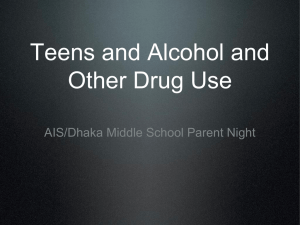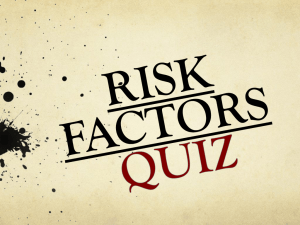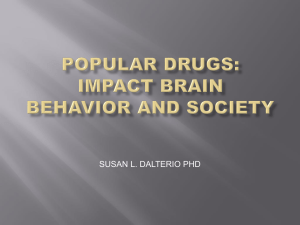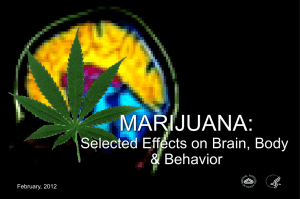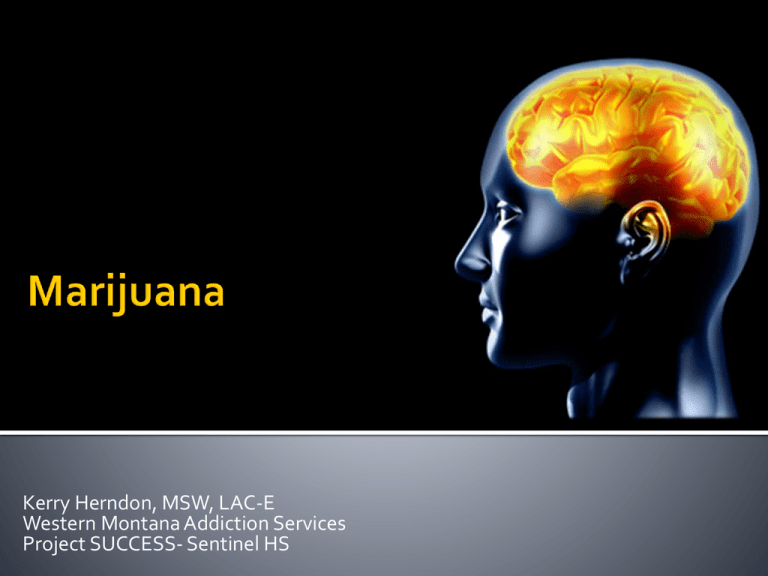
Kerry Herndon, MSW, LAC-E
Western Montana Addiction Services
Project SUCCESS- Sentinel HS
THIS PRESENTATION
IS ABOUT MARIJUANA
AND YOUR HEALTH.
Regardless of the politics and
debate about legalization
these are the facts about how
marijuana impacts your health.
Age 25: Fully Developed
Age 30: Fully Mature
Younger any chemicals are
introduced, the greater the
risk to brain development
Neurotransmitters
The chemical (message) being sent
Neuron
Specialized cell which sends or receives messages
to other parts of our nervous system.
Hash
Cannabis
Pot
Joint
Afgan
Black Rock
Grass
Dope
Bhang
Weed
Bush
Draw
Broccoli
Budda Grass
Dry High
Dubby
Gage
Ganja
Gangster
Giggleweed
Hemp
Herb
Jive
Kiff
Jane
Mary Jane
Loco Weed
Mexican Green
Panama Red
Puff
Resin
Roach
Reefer
Sativa
Smoke
Spliff
Tea
Texas Tea
Thai Sticks
Skunk
Chronic
Cheeba
Bammy
Blanket
Blunt
Ashes
Bo-Bo
Bomber
Ding
Giggle Smoke
Cripple
Dinkie Dow
Smoked
Ingested
Vaporized
10-20x more potent than in 1970’s
50-70% more carcinogens than cigarettes
Type or carcinogens vary
Marijuana has over 4,000 unidentified
chemicals, including more than 50 linked to
cancer.
Inhaled deeply and held for longer periods in the
lungs, increasing tar in lungs.
(Moir et al., 2008)
It is a “gateway drug” (dopamine).
Adolescents who use marijuana are more likely to use cocaine
and/or heroin as adults.
(SAMHSA, 2002)
Although typically not lethal, mixed with other
substances (especially alcohol) it can have serious
consequences.
Although it is rare, you can overdose. Some symptoms
are:
acute anxiety or panic
increased heart rate
low blood pressure
psychosis or paranoia.
About 9% of people become addicted
“The odds of marijuana dependence in adulthood are 6
times higher for those who started using pot before age
15 than for those who began after age 18.”
Increases to 25 to 50% among daily users.
“While alcohol is the leading cause of emergency room
admissions for adults, for adolescents, it is marijuana.”
(HBO Box Office, Inc, 2007)
(HBO Box Office, Inc, 2007)
“Complaints include delusions, hallucinations,
automobile accidents and more serious psychological
and physical reactions when marijuana is combined
with other addictive substances.
(HBO Box Office, Inc, 2007)
Bloodshot eyes
Dry mouth and throat
Decreased social inhibitions
Motivation and cognition
Learning difficulties
Difficulty speaking, listening effectively
Intense anxiety or panic attacks
Paranoia
Drops blood pressure
“Whoa, Dude, I gotta sit down”.
Impacts nerve cells, hippocampus, cerebellum, basal ganglia, and
cerebral cortex.
Can cause:
Hallucinations
Delusions
Impaired memory
Disorientation
Parts of Brain that Effect:
Pleasure
Memory
Thought
Concentration
Sensory and time perception
Coordinated movement
Nucleus of Solitary Tract – Sensations like nausea and vomiting
Basal Ganglia – Movement Control
Cerebellum – Body Movement & Coordination
Hippocampus – Memory, Learning, Stress Control
Cerebral Cortex – Thinking, Problem Solving
Nucleus Accumbens – Reward Center
Hypothalamus – Body Functions
Amygdala – Emotional Response, Fears
Spinal Cord – Sensations
Brain Stem – Sleep, Arousal, Motor Control
Heart rate (increase up to 50%)
Blood pressure drops
Heart attack 4x more likely within an hour of
smoking marijuana compared to not smoking
Burning and stinging of the throat
Heavy coughing/Similar to tobacco smokers
Frequent chest illnesses & lung infections
Cancer of the lung (20x greater w/ marijuana
compared to tobacco per study in 2012)
Type of lung cancer maybe different that cigarette smokers due to
cannabinoid carcinogens vs. tobacco carcinogens. Cannabis may kill or
slow the growth of some cancer cells, but it can also been shown in other
studies to increase risk or cause cancer cell growth of a different type.
Correlation to:
bullous lung disease (abnormal airspaces in lungs caused by damage to lung walls)
pneumothorax (“collapsed lung”)
(http://adai.uw.edu/marijuana/factsheets/respiratoryeffects.htm)
Tar similar to that of tobacco, but levels increase
w/ marijuana due to inhaling it and holding it in
lungs longer.
“…there is a prolonged and deeper inhalation and it is smoked
to a shorter butt length and at a higher combustion
temperature. This results in approximately 5 times the carbon
monoxide concentration, 3 times the tar, and the retention of
one-third more tar in the respiratory tract. Higher levels of
ammonia and hydrogen cyanide have also been found in
marijuana smoke, compared to tobacco”
(Moir, et al., 2008; Wu et al., 1988; Tashkin et al., 1991; Benson & Bentley, 1995).
Smoking devices that use water filters (bongs, e.g.) have been
shown to involve equivalent amounts of tar and do not reduce
risks of marijuana smoke inhalation (Gieringer, 1996; Bloor et al, 2008).
Vaporizers, which heat marijuana below combustion point, have
been theorized to be a safer method of administration,
producing lower levels of tar than cigarettes (Grotenhermen, 2001) and fewer
respiratory symptoms reported by users (Earleywine & Smucker Barnwell, 2007).
However, these devices have also been shown to release
ammonia which, when inhaled, can cause irritation and central
nervous system effects, as well as asthma and bronchial spasms
(Bloor et al, 2008). More research on the potential use of vaporizers as a
harm reduction technique is needed.
http://adai.uw.edu/marijuana/factsheets/respiratoryeffects.htm
Eating marijuana ("edibles") is perhaps a more obvious means to reduce
the respiratory effects when using the drug. Oral administration carries its
own challenges, however, as it typically takes longer for the effects of the drug
to appear (30–60 minutes compared to seconds), making it more difficult to
monitor dose and increasing the risk of overdose. Additionally, the effects last
longer than some users prefer (Grotenhermen, 2001). That said, overdosing on marijuana
is rare and most likely to happen to naïve users. A marijuana overdose can
trigger acute anxiety or panic, increased heart rate, low blood pressure, and
additional problems.
Other alternative forms of marijuana delivery, including sublingual,
rectal, and transdermal delivery have not been appropriately investigated but
may also further reduce the possible risks associated with the administration
of cannabis (Grotenhermen, 2001).
http://adai.uw.edu/marijuana/factsheets/respiratoryeffects.htm
Can induce psychosis
Anxiety
Depression
Schizophrenia
Bipolar Disorder
Panic attacks
Learning difficulties/disabilities
Emotional development
Which comes first? Mental health or triggered
symptoms as a result of marijuana.
Adolescents 6x more likely to develop psychotic
symptoms
10% of adolescents who use before age 15 will
develop psychotic symptoms by age 26 compared
to 3% who never used.
Genetically predisposed people are likely to see
symptoms of mental health disorders earlier if they
use marijuana.
Young men who use are more likely to experience
suicidal thoughts if they use marijuana.
Burning and stinging of mouth/throat
Changes in potassium levels
Changes in amount of protein and Ph of urine
Some renal problems reported as a result
having to digest the marijuana
UA’s
▪ Occasional Use -10 to 14 days
▪ Regular Use -45 days
▪ Heavy Use – 90 days
Lowered immune system
Cancer patients in treatment may be
impacted differently by the effect of
marijuana on the immune system.
Suppress auto-immune system
Reduces white cell production
Slows muscle growth
Decreases muscle mass
Lowers testosterone needed
for muscle growth
Used as a muscle relaxant
Increased muscle spasms
Absorption of calcium reduced
Weakened bones (especially in adolescent
women)
Recreational use linked to testicular cancer
Cannabis receptors in the testacies
Female infertility issues
THC can be found in vaginal fluids
Interference with menstrual and ovulation cycles
Male infertility issues
Lower sperm count/mobility of sperm impacted
Lower volume of seminal fluid
Reduced testosterone
Effects different people in a different way
BHA: Food additive ingested while using
marijuana can promote health effects in
lungs.
Males more likely to develop dependency
Higher risk taking behaviors
Denial of organ transplants
Most pronounced 1018 days after last use
Peaking at day 2 or 3
Tremors
Fever like feeling
Nausea
Muscle spasms
Loose stools
Abdominal distress
Hiccups
Anxiety
Muscle tension
Mood swings
Appetite changes
Insomnia
Nightmares/terrors
Depressed mood
Anger/Aggression
Agitation
Irritable
Resources had varying information about marijuana. Unless a resource is directly
cited, the information came by reading multiple articles, professional resources, etc.
Every article, book or resource on marijuana ever encountered would need to be
listed to capture the host of information obtained for this presentation.
http://adai.uw.edu/marijuana/factsheets/respiratoryeffects.htm




